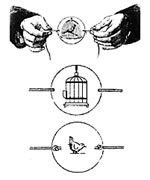Vintage Virtual Reality
"Workers Leaving the Lumière Factory", March 22 1895
Since this post deals with the subject of "virtual reality" or VR, I though it would be interesting to note certain antecedents and explain some technical aspects that might give you food for thought. Although one of the modern tenets of VR is the "interactivity" aspect (and that is another discussion topic) earlier attempts were more concerned with "immersion" and this is true still today, as total immersion is a primary focus of VR designers today.
Jean-Luc Godard, one of the most influential film critics and filmmakers of the New Wave, once defined film as "...24 frames per second".
Coming from one of the most intellectual directors in film history this definition seems simplistic. But Godard was in fact referring to the fact that film was an illusion created in our minds by a simple physical phenomena. For many years we were told that the reason film works the way it works is because of the "lag" produced by our vision system, which does not "refresh" the image fast enough, resulting in the images blending with the previous one and so forth, therefore creating the illusion of movement.

Everyone has probably at one point played with the illusion of the "bird in a cage".
The thaumatrope, as this is called was a very popular toy dating to the Victorian era, and is often considered an antecedent of cinematography and particularly of animation. As a curious note some claim that Charles Babbage, who originated the concept of the programmable computer, was its inventor, although no definite proof of this exists.
Many still believe that "persistence of vision" is the phenomena behind the perception of movement in cinema, a "lucky defect of the retina" which permitted this illusion.
Movement, however, is a phenomena perceived directly by the brain, through different sensors with which it interacts. In this respect, the eye acts as a gate which transmits to the brain a frequency. And here we come around Godard's 24 fps or frames per second. Although early cinematographers arrived at this particular frequency empirically, they did not exactly know why the perception of movement was so "realistic" at this frame rate.
The brain produces different types of waves, like Alpha and Beta, associated with different "states of mind". This electromagnetic oscillations convey different sensations based on the information acquired by the senses. These wave frequencies range from 8 to 12 hz to 12 to 15hz respectively of which 24 and 30, the most common film and video rates are multiples.
I believe, based on my own experiments as an special effects (SFX) cinematographer that this results in a "feedback" loop, amplifying the electrical activity of the thalamic cells, responsible for the communication between the senses and the thalamus, which plays a major role in regulating arousal, level of awareness or consciousness and activity.
In 1983, Douglas Trumbull, the special effects supervisor for such films as 2001: A Space Odyssey, Close Encounters of the Third Kind, Star Trek: The Motion Picture and Blade Runner, directed his first major film, "Brainstorm" which predicted the fascination with virtual reality and developed a system for this film named Showscan, which was shot and projected at 60 frames per second. The effect for the viewers was an incredibly enhanced high definition and movement experience, described by some as a "psychedelic drug trip".

I describe the experience of viewing a film (at 24 and particularly at 60 fps) as a mild epileptic seizure since the frequency of projection greatly enhances the synchronous electrical activity of the brain. This is what is mainly responsible for the high degree of "immersion" that both film and TV effect in the viewer, regardless of content. And it is in this respect that Marshall McLuhan's phrase "the medium is the message" makes total sense.
I think I will leave it at that for now as a trigger point (pun intended) for a future conversation about the subject.
In 1983, Douglas Trumbull, the special effects supervisor for such films as 2001: A Space Odyssey, Close Encounters of the Third Kind, Star Trek: The Motion Picture and Blade Runner, directed his first major film, "Brainstorm" which predicted the fascination with virtual reality and developed a system for this film named Showscan, which was shot and projected at 60 frames per second. The effect for the viewers was an incredibly enhanced high definition and movement experience, described by some as a "psychedelic drug trip".

I describe the experience of viewing a film (at 24 and particularly at 60 fps) as a mild epileptic seizure since the frequency of projection greatly enhances the synchronous electrical activity of the brain. This is what is mainly responsible for the high degree of "immersion" that both film and TV effect in the viewer, regardless of content. And it is in this respect that Marshall McLuhan's phrase "the medium is the message" makes total sense.
I think I will leave it at that for now as a trigger point (pun intended) for a future conversation about the subject.
Comments